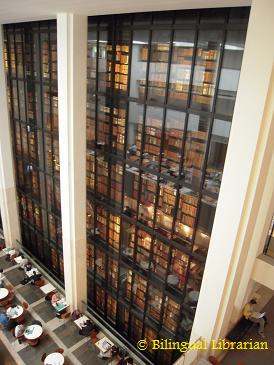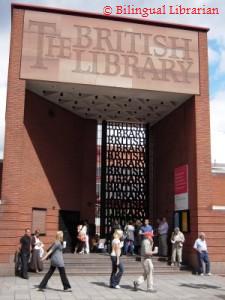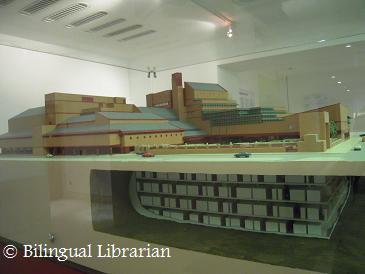 This afternoon I had an appointment for a tour of The British Library. The library itself is huge, taking up the better part of a city block, and having so much storage it has 5 underground levels full of books, plus additional storage at a remote location. Being the national library, it is in charge of keeping a copy of every single book published in the UK and Ireland; but by now this means more than 15 millions books, and counting.
This afternoon I had an appointment for a tour of The British Library. The library itself is huge, taking up the better part of a city block, and having so much storage it has 5 underground levels full of books, plus additional storage at a remote location. Being the national library, it is in charge of keeping a copy of every single book published in the UK and Ireland; but by now this means more than 15 millions books, and counting.
But impressive numbers aside, the library also holds some very impressive items and special collections. As you walk into the building you can’t help but notice a glass column, full of books, reaching as far as the ceiling. This is known as the Kings Library; it’s the collection of King George III, and was donated to the nation by his son George IV back in 1823. The collection includes 65,000 volumes, 20,000 pamphlets, and over 400 manuscripts. And this is a working library, consulted daily by researches from around the world.
The library also includes The Sir John Ritblat Gallery: Treasures of the British Library; here you’ll find manuscripts for Alice in Wonderland, The Hours, compositions by the Beatles, Leonardo da Vinci’s notebook, illuminated manuscripts from India, Shakespeare’s first folio, Sultan Baybar’s Qu’ran, two Gutenberg Bibles, and in a small side room, the Magna Carta! (And by the way, you can actually page through many of these treasure through the library’s Virtual Books collection.)
The treasure room also holds the library’s holdings of the Codex Sinaiticus. This codex, written well over 1600 years ago contains the Christina bible in Greek, including the oldest complete copy of the New Testament. The codex has been divided into four pieces, with the British Library holding 694 pages of it, the Leipzig University Library holds 86 pages, the St. Catherine’s Monastery in Sinai holds 36 pages, and the National Library of Russia in St. Petersburg holds 8 pages.
The British Library acquired its portion of the codex when it purchased it from the book dealer Ernest Maggs on December 27, 1933, The codex has been on public display at the library every since. Currently there is a project to digitally reunite the full codex, and the British Library has another display in one of the main corridors explaining the project.
Yes, the British Library was quite impressive, the only thing I regret was not being able to see that gorgeous round reading room I’ve seen in so many pictures. That reading room is in the British Museum, former home to the British Library, until the mid 90s when the outgrew the space, and moved to their current location. And I did go to the British Museum to see the famous reading room, but unfortunately it is closed to the public until 2012.
I went back to the library on Sunday to see the Henry VIII exhibit which was also very good. I spent close to 3 hours looking at the collection, which included old portraits, letters, diaries, legal documents, books, and even a knight’s helmet. The exhibit documented Henry VIII entire life, from a childhood reared by women, to being crowned as a teenager, along with lots of primary documentation on his many marriages, and as well as his political legacy.
Suffice to say that I’ve never before seen people line up, waiting for a library to open its doors on a Sunday morning.
Esta tarde he tenido una cita para un tour de The British Library. La biblioteca es enorme, cubriendo la mayor parte de una manzana, y tiene tanta capacidad de almacenamiento que tiene 5 niveles subterráneos llenos de libros, además de almacenamiento en una ubicación remota. Siendo la biblioteca nacional, esta encargada de mantener una copia de cada libro publicado en el Reino Unido e Irlanda; por ahora esto significa más de 15 millones de libros, y creciendo cada día.
Impresionante, pero dejando los números de lado, la biblioteca también tiene algunas piezas muy impresionante en sus colecciones especiales. Entrando al edificio no se puede evitar notar una columna de vidrio, que llega hasta el techo, llena de libros. Esta se la Biblioteca del Rey; es la colección del rey George III, y fue donada a la nación por su hijo George IV en 1823. La colección incluye 65.000 volúmenes, 20.000 folletos, y más de 400 manuscritos. Es una biblioteca de trabajo, consultada a diario por investigadores de todo el mundo.
La biblioteca también incluye la Galería Sir John Ritblat: Tesoros de la Biblioteca Británica, aquí encontrarás los manuscritos de Alice in Wonderland, Las horas, composiciones de los Beatles, el cuaderno de Leonardo da Vinci, manuscritos iluminados de la India, el primer folio de Shakespeare, el Corán del Sultán Baybar, dos biblias de Gutenberg, y en una pequeña sala lateral, la Carta Magna. (Y, por cierto, a través del proyecto Libros Virtuales de la biblioteca, podrá ojear muchos de estos tesoros.)
La sala de tesoro también contiene el Codex Sinaiticus. Este códice, escrito hace más de 1600 años contiene la Bíblia cristiana en griego, incluyendo la copia más antigua del Nuevo Testamento. El códice se ha dividido en cuatro piezas, guardadas en la Biblioteca Británica, con 694 páginas de la misma; la Biblioteca de la Universidad de Leipzig tiene 86 páginas; el Monasterio de Santa Catalina del Sinaí tiene 36 páginas; y la Biblioteca Nacional de Rusia en San Petersburgo tiene 8 páginas.
La Biblioteca Británica adquirió su parte del código de el distribuidor Ernest Maggs el 27 de diciembre de 1933. El códice ha estado en exposición pública en la biblioteca desde entonces. Actualmente existe un proyecto para reunir digitalmente el códice, y la British Library tiene otra exhibición en uno de los principales corredores explicando el proyecto.
Sí, la British Library es bastante impresionante, lo único que lamento es no poder haber visto esa magnífica sala de lectura redonda que he visto en tantas fotos. La sala de lectura se encuentra en el Museo Británico, que fue el antiguo hogar de la Biblioteca Británica, hasta mediados de los años 90 cuando les quedo chico el espacio, y se trasladó a su ubicación actual. Fui hasta Museo Británico para ver la famosa sala de lectura, pero, desafortunadamente está cerrada al público hasta el 2012.
 Volví a la biblioteca el domingo para ver la exposición de Henry VIII, también muy buena. Pasé cerca de 3 horas mirando la colección, que incluía retratos antiguos, cartas, diarios, documentos jurídicos, libros, e incluso un casco de caballero. La exposición documenta toda la vida, de Henry VIII, desde una infancia criados por mujeres, hasta ser coronado siendo todavía un adolescente, junto con un montón de documentación primaria en sus muchos matrimonios, así como su legado político.
Volví a la biblioteca el domingo para ver la exposición de Henry VIII, también muy buena. Pasé cerca de 3 horas mirando la colección, que incluía retratos antiguos, cartas, diarios, documentos jurídicos, libros, e incluso un casco de caballero. La exposición documenta toda la vida, de Henry VIII, desde una infancia criados por mujeres, hasta ser coronado siendo todavía un adolescente, junto con un montón de documentación primaria en sus muchos matrimonios, así como su legado político.
Basta decir que nunca antes había visto a nadie haciendo fila, un domingo por la mañana, a la espera de que una biblioteca abra sus puertas.
